Iron Based Superconductors
The nature of the magnetic order in superconductors has had a rich and interesting history, and has been a special topic of interest ever since the parent materials of the high TC cuprates were found to be antiferromagnetic Mott insulators that exhibit huge exchange energies within the Cu-O planes. The more recent discovery of superconductivity in the rare-earth (R) iron-based oxide systems RO1-xFxFeAs (R = rare earth) and the (Ca,Ba,Sr)1-xKxFe2As2 has generated enormous interest because these materials are the first non-copper oxide superconductors with Tc's exceeding 50 K. The parent (non-superconducting) materials like LaOFeAs and SrFe2As2 are metallic but show anomalies near 150-200 K in both resistivity and dc magnetic susceptibility. We have used neutron scattering at the NCNR to explore the crystal and magnetic structures of many of these materials, and have found that the parent materials undergo an abrupt structural distortion below ~150-200 K (depending on the system), changing the symmetry from tetragonal (space group P4/nmm) to orthorhombic (space group Cmma) at low temperatures. This structural transition is the primary cause of transport and thermodynamic anomalies, but it is closely followed by the development of long range SDW-type antiferromagnetic order, at or just below the structural transition. The magnetic structures are all simple, commensurate configurations, but with a small ordered moment ranging from 0.25 to just under 1 µB. The small moment indicates that these are itinerant electron systems, and that the ordering can be described as the spin-density-wave type. The measured spin wave dispersion relations yield a magnon bandwidth of ~0.2 eV, a very large energy scale compared to the ordering temperature, again much like the cuprates . Doping the system suppresses both the magnetic order and structural distortion in favor of superconductivity, while strongly correlated (energetic) spin fluctuations persist in the superconducting regime. Therefore, much like high-Tc copper oxides, the superconducting regime in these Fe-based materials occurs in close proximity to a long-range ordered and very energetic antiferromagnetic ground state. Indeed, a strong magnetic resonance is observed when these systems become superconducting, with an intensity that follows the form of a superconducting order parameter, just like the cuprates (and some heavy fermion systems). It therefore appears likely that magnetic fluctuations are at the heart of the superconducting pairing. Certainly any theoretical description of these materials must provide a natural framework to understand the origin of the very energetic spin excitations in these materials. The basic properties of these very interesting materials are reviewed in Physica C 469. 469 (2009).
For the undoped (Ca,Ba,Sr)Fe2As2 systems, pressure has been found to drive them superconducting. Our pressure and temperature-dependent neutron diffraction measurements for CaFe2As2 show that a transition from the ambient-pressure magnetically ordered orthorhombic phase to a non-magnetic "collapsed" tetragonal phase occurs. By "collapsed" we mean that the c-axis decreases by 10% together with an overall 5% reduction in the unit cell volume, while band structure calculations indicate that the Fe moment has collapsed as well. The huge and very anisotropic change in the crystal structure changed the interpretation of the superconductivity measurements, since the initial measurements were carried out using a solid pressure medium rather than hydrostatic pressure as was done for the diffraction measurements. It turns out that the collapsed phase is not superconducting under hydrostatic pressure, but is superconducting under the anisotropic pressure where the a-b plane is compressed and the c-axis is relaxed, which could have interesting implications for thin film properties. Phys. Rev. B 78, 184517 (2008); Phys. Rev. B 79, 024513 (2009). Phys. Rev. B 85, 024525 (2012).
The structural transition to this collapsed phase can also occur by applying 'chemical pressure', for example by substitution smaller rare earth elements such as Pr or Nd onto the Ca site (Ca1-xRx)Fe2As2 (Phys. Rev. B 85, 024525 (2012)).The structural and magnetic ordering can then be investigated simply by changing temperature at ambient pressure. Surprisingly, with sufficient doping superconductivity up to 47 K develops in this collapsed tetragonal phase. More surprising is that the same type of high Tc superconductivity is observed when larger rare earth (for example Ce or La) are substituted and no collapsed phase is induced. However, only a relatively small fraction of the system goes superconducting, and elucidating the origin and nature of this superconductivity is an active area of investigation.
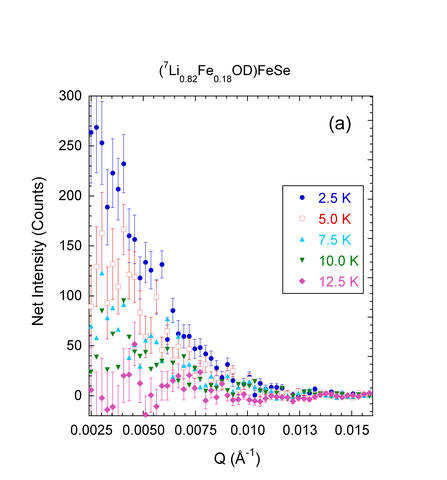
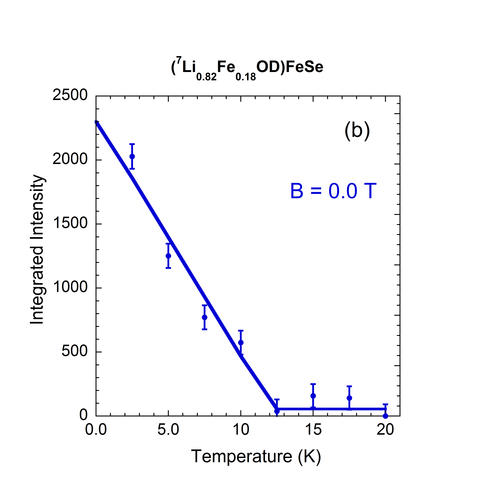
(a) Magnetic scattering as a function of wave vector Q for several temperatures. No magnetic field is applied. At 12.5 K very little magnetic scattering is observed, as is the case at higher temperatures. Below the ferromagnetic transition magnetic scattering intensity develops, which increases monotonically with both decreasing Q and T. No peak in this Q range is observed, ruling out the formation of a long range ordered oscillatory magnetic state. (b) Integrated intensity as a function of temperature, revealing a magnetic transition temperature of ~12.5 K. Uncertainties are statistical in origin and represent one standard deviation.
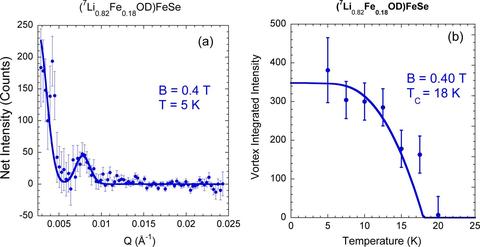
(a) Magnetic intensity at 5 K after cooling from 25 K in an applied field of 0.4 T. The ferromagnetic scattering has shifted to smaller Q, indicating that the length scale or strength for this scattering has increased as would be expected when a field is applied. The peak at Q = 0.0077 Å-1 is due to vortex scattering. (b) Integrated intensity of the vortex scattering as a function of temperature. The onset of scattering occurs at TC = 18 K. No evidence of the ferromagnetic ordering is observed, indicating that the ordered moment is small.
Below is a list of publications, including a few reviews of the NCNR work.
Magnetic Order Close to Superconductivity in the Iron-based Layered La(O1-xFx)FeAs systems, C. de la Cruz, Q. Huang, J. W. Lynn, J. Li, W. Ratcliff II, J. L. Zarestky, H. A. Mook, G. F. Chen, J. L. Luo, N. L. Wang, and P. Dai, P. Dai, Nature 453, 899 (2008). Supplementary Material.
Intrinsic Properties of Stoichiometric LaOFeP, T. M. McQueen, M. Regulacio, A. J. Williams, Q. Huang, J. W. Lynn, Y. S. Hor, D.V. West, and R. J. Cava, Phys. Rev. B 78, 024521 (2008).
Neutron scattering study of the oxypnictide superconductor LaO0.87F0.13FeAs, Y. Qiu, M. Kofu, Wei Bao, S.-H. Lee, Q. Huang, T. Yildirim, J. R. D. Copley, J. W. Lynn, T. Wu, G. Wu, and X. H. Chen, Phys. Rev. B 78, 052508 (2008).
Magnetic Order of the Iron Spins in NdOFeAs, Y. Chen, J. W. Lynn, G. F. Chen, G. Li, Z. C. Li, J. L. Luo, N. L. Wang, P. Dai, C. dela Cruz, and H. A. Mook, Phys. Rev. B 78 , 064515 (2008).
Doping Evolution of Antiferromagnetic Order and Structural Distortion in LaFeAsO1-xFx, Q. Huang, J. Zhao, J. W. Lynn, G. F. Chen, J. L. Lou, N. L. Wang, and P. Dai, Phys. Rev. B 78, 054529 (2008).
Structural and Magnetic Phase Diagram of CeFeAsO1-xFx and its Relationship to High-Temperature Superconductivity, J. Zhao, Q. Huang, C. de al Cruz, S. Li, J. W. Lynn, Y. Chen, M. A. Green, G. F. Chen, G. Li, Z. C. Li, J. L. Luo, N. L. Wang, and P. Dai, Nature Materials 7, 953 (2008).
Spin and Lattice Structure of Single Crystal SrFe2As2, Jun Zhao, W. Ratcliff-II, J. W. Lynn, G. F. Chen, J. L. Luo, N. L. Wang, Jiangping Hu, and Pengcheng Dai, Phys. Rev. B 78, 140504(R) (2008).
Low energy spin waves and magnetic interactions in SrFe2As2, J. Zhao, D.-X. Yao, S. Li, T. Hong, Y. Chen, S. Chang, W. Ratcliff II, J. W. Lynn, H. A. Mook, G. F. Chen, J. L. Luo, N. L. Wang, E. W. Carlson, J. Hu, and P. Dai, Phys. Rev. Lett. 101, 167203 (2008).
Lattice and Magnetic structures of PrFeAsO, PrFeAsO0.85F0.15 and PrFeAsO0.85, Jun Zhao, Q. Huang, Clarina de la Cruz, J. W. Lynn, M. D. Lumsden, Z. A. Ren, Jie Yang, Xiaolin Shen, Xiaoli Dong, Zhongxian Zhao, and Pengcheng Dai, Phys. Rev. B 78, 132504 (2008).
Pressure-induced Volume-collapsed Tetragonal Phase of CaFe2As2 as seen via Neutron Scattering, A. Kreyssig, M. A. Green, Y. B. Lee, G. D. Samolyuk, P. Zajdel, J. W. Lynn, S. L. Bud'ko, M. S. Torikachvili, N. Ni, S. Nandi, J. Leão, S. J. Poulton, D. N. Argyriou, B. N. Harmon, P. C. Canfield, R. J. McQueeney, and A. I. Goldman, Phys. Rev. B 78, 184517 (2008).
The crystalline electric field as a probe for long range antiferromagnetic order and superconductivity in CeFeAsO1−xFx, S. Chi, D. T. Adroja, T. Guidi, R. Bewley, Shliang Li, Jun Zhao, J. W. Lynn, C. M. Brown, Y. Qiu, G. F. Chen, J. L. Lou, N. L. Wang, and Pengcheng Dai, Phys. Rev. Lett. 101, 217002 (2008).
Neutron-Diffraction Measurements of Magnetic Order and a Structural Transition in the Parent BaFe2As2 Compound of FeAs-Based High-Temperature Superconductors, Q. Huang, Y. Qiu, W. Bao, M.A. Green, J. W. Lynn, Y. C. Gasparovic, T. Wu, G. Wu, and X. H. Chen, Phys. Rev. Lett. 101, 257003 (2008).
Crystal Structure and Antiferromagnetic Order in NdFeAsO1-xFx (x = 0.0 and 0.2): Superconducting Compounds from Neutron Diffraction Measurements, Y. Qiu, W. Bao, Q. Huang, T. Yildirim, J. M. Simmons, M. A. Green, J. W. Lynn, Y. C. Gasparovic, J. Li, T. Wu, G. Wu, and X. H. Chen, Phys. Rev. Lett. 101, 257002 (2008).
Neutron Studies of the Iron-based Family of High Tc Magnetic Superconductors, J. W. Lynn, Mater. Res. Soc. Symp. Proc. 1148, PP02-05 (2008).
Lattice Collapse and Quenching of Magnetism in CaFe2As2 under Pressure: A Single Crystal Neutron and X-ray Diffraction Investigation, A. I. Goldman, A. Kreyssig, K. Prokes, D. K. Pratt, D. N. Argyriou, J. W. Lynn, S. Nandt, S. A. Kimber, Y. Chen, Y. B. Lee, G. Samolyuk, J. Leao, S. J. Poulton, S. L. Bud'ko, N. Ni, P. C. Canfield, B. N. Harmon, and R. J. McQueeney, Phys. Rev. B 79, 024513 (2009).
First-order Magnetic and Structural Phase Transitions in Fe1+ySexTe1-x, S. Li, C. de la Cruz, Q. Huang, Y. Chen, J. W. Lynn, J. Hu, Y-L Huang, F-C. Hsu, K-W. Yeh, M-K. Wu, and P. Dai, Phys. Rev. B 79, 054503 (2009).
Neutron Studies of the Iron-based Family of High TC Magnetic Superconductors, Jeffrey W. Lynn and Pengcheng Dai, Physica C 469. 469 (2009).
Spin gap and Magnetic Resonance in Superconducting BaFe1.9Ni0.1As, S. Li, Y. Chen, S. Chang, J. W. Lynn, L. Li, Y. Luo, G. Cao, Z. Xu, and P. Dai, Phys. Rev. B 79, 174527 (2009).
Evolution of the bulk properties, structure, magnetic order, and superconductivity with Ni doping in CaFe2-xNixAs2, Neeraj Kumar, Songxue Chi, Ying Chen, Gaurav Rana, A. K. Nigam, A. Thamizhavel, W. Ratcliff II, S. K. Dhar, and Jeffrey W. Lynn, Phys. Rev. B 80, 144524 (2009).
Iron-based Superconductors, Jeffrey W. Lynn, McGraw-Hill Yearbook of Science and Technology 2010, p. 204 (McGraw-Hill, New York, 2010).
Lattice distortion and Magnetic Quantum Phase Transition in CeFeAs1-xPxO, C. de la Cruz, W. Z. Hu, S. Li, Q. Huang, J. W. Lynn, M. A. Green, G. F. Chen, N. L. Wang, H. A. Mook, Q. Si, and P. Dai, Phys. Rev. Lett. 104, 017204 (2009).
Magnetic Form Factor of SrFe2As2: Neutron Diffraction Measurements, W. Ratcliff II, P. A. Kienzle, J. W. Lynn, S. Li, P. Dai, G. F. Chen and N. L. Wang, Phys. Rev. B 81, 140502(R) (2010).
Electron-doping Evolution of the Low-energy Spin Excitations in the Iron Arsenide BaFe2-xNixAs2 Superconductors, Miaoyin Wang, Huiqian Luo, Jun Zhao, Chenglin Zhang, Meng Wang, Karol J. Marty, Songxue Chi, Jeffrey W. Lynn, Astrid Schneidewind, Shiliang Li, and Pengcheng Dai, Phys. Rev. B 81, 174524 (2010).
Magnetic and Structural Properties of Ca(Fe1-xCox)2P2 and Ca(Ni1-xCox)2P2, S. Jia, S. Chi, J. W. Lynn and R. J. Cava, Phys. Rev. B 81, 214446 (2010).
Doping Dependence of Spin Dynamics in Electron-Doped Ba(Fe1−xCox)2As2, K. Matan, S. Ibuka, R. Morinaga, S. X. Chi, J. W. Lynn, A. D. Christianson, M. D. Lumsden, and T. J. Sato, Phys. Rev. B 82, 054515 (2010); Erratum: Phys. Rev. B 83, 059901 (2011).
Interplay between Fe and Nd magnetism in NdFeAsO single crystals, W. Tian, W. Ratcliff II, J.W. Lynn, J.-Q. Yan, M.G. Kim, B. Jensen, K. Dennis, R.W. McCallum, T.A. Lograsso, R.J. McQueeney, A.I. Goldman, A. Kreyssig, Phys. Rev. B 82, 060514(R) (2010).
Antiferromagnetic Critical Fluctuations in BaFe2As2, Stephen D. Wilson,, Z. Yamani, C. R. Rotundu, B. Freelon, P. N. Valdivia, E. Bourret-Courchesne, J. W. Lynn, Songxue Chi, Tao Hong, and R. J. Birgeneau, Phys. Rev. B 82, 144502 (2010).
Magnetic field effect on the static antiferromagnetic order and spin excitations in the underdoped iron arsenide superconductor BaFe1.92Ni0.08As2, M Wang, H. Luo, M. Wang, S. Chi, J. A. Rodriguez-Rivera, D. Singh, S. Chang, J. W. Lynn, and P. Dai, Phys. Rev. B 83, 094516 (2011).
Antiferromagnetic Spin Excitations in Single Crystals of Nonsuperconducting Li1−xFeAs, Meng Wang, X. C. Wang, D. L. Abernathy, L. W. Harriger, H. Q. Luo, Yang Zhao, J. W. Lynn, Q. Q. Liu, C. Q. Jin, Chen Fang, Jiangping Hu, and Pengcheng Dai, Phys. Rev. B 83, 220515(R) (2011).
Neutron Scattering Studies of Spin Excitations in Hole-doped Ba0.67K0.33Fe2As2 Superconductor, Chenglin Zhang, Meng Wang, Huiqian Luo, Miaoyin Wang, Mengshu Liu, Jun Zhao, D. L. Abernathy, T. A. Maier, Karol Marty, M. D. Lumsden, Songxue Chi, Sung Chang, Jose A. Rodriguez-Rivera, J. W. Lynn, Tao Xiang, Jiangping Hu, Pengcheng Dai, Scientific Reports 1, 115 (2011).
Common Origin of the two types of Magnetic Fluctuations in Iron Chalcogenides, Songxue Chi, J. A. Rodriguez, J. W. Lynn, Chenglin Zhang, D. Phelan, D. K. Singh, R. Paul, and Pengcheng Dai, Phys. Rev. B 84, 214407 (2011).
Structural Collapse and 45 K Superconductivity in Electron-doped CaFe2As2, S. R. Saha, N. P. Butch, T. Drye, J. Magill, S. Ziemak, K. Kirshenbaum, P. Y. Zavalij, J. W. Lynn, and J. Paglione, Phys. Rev. B 85, 024525 (2012).
Coexistence and Competition of the Short-Range Incommensurate Antiferromagnetic Order with the Superconducting State of BaFe2-xNixAs2, Huiqian Luo, Rui Zhang, Mark Laver, Meng Wang, Xingye Lu, Miaoyin Wang, Yanchao Chen, Shiliang Li, Zahra Yamani, Sung Chang, Jeffrey W. Lynn, and Pengcheng Dai, Phys. Rev. Lett. 108, 247002 (2012).
From Antiferromagnetic Insulator to Correlated Metal in Pressurized and Doped LaMnPO, J. W. Simonson, Z. Yin, M. Pezzoli, J. Guo, J. Liu, K. Post, A. Efimenko, N. Hollmann, Z. Hu, H.-J. Lin, C. T. Chen, C. Marques, V. Leyva, G. Smith, J. W. Lynn, L. Sun, G. Kotliar, D. N. Basov, L. H. Tjeng, and M. C. Aronson, Proceedings of the National Academy of Science 109, 10751 (2012).
Tuning Magnetism in FeAs-based Materials via a Tetrahedral Structure, K. Kirshenbaum, N. P. Butch, S. R. Saha, P. Y. Zavalij, B. G. Ueland, J. W. Lynn, and J. Paglione, Phys. Rev. B 86, 060504(R) (2012).
Magnetic Neutron Diffraction Study of Ba(Fe1-xCox)2As2 Critical Exponents through the Tricritical Doping, D. M. Pajerowski, C. R. Rotundu, J. W. Lynn, and R. J. Birgeneau, Phys. Rev. B 87, 134507 (2013).
Uniaxial pressure effect on structural and magnetic phase transitions in NaFeAs and its comparison with as-grown and annealed BaFe2As2, Yu Song, Scott V. Carr, Chenglin Zhang, Zachary C. Sims, N. F. Luttrell, Xingye Lu, Songxue Chi, Zhao Yang, Jeffrey W. Lynn, and Pengcheng Dai, Phys. Rev. B 87, 184511 (2013).
Coexistence of half-metallic itinerant ferromagnetism with robust local moment antiferromagnetism in Ba0.60K0.40Mn2As2, Abhishek Pandey, B. G. Ueland, S. Yeninas, A. Kreyssig, A. Sapkota, Yang Zhao, J. S. Helton, J. W. Lynn, R. J. McQueeney, Yuji Furukawa, A. I. Goldman, and D. C. Johnston, Phys. Rev. Lett. 111, 047001 (2013).
Distinguishing s± and s++ electron pairing symmetries by neutron spin resonance in superconducting NaFe0.935Co0.045As, Chenglin Zhang, H.-F. Li, Yixi Su, Guotai Tan, Yu Song, Tucker Netherton, Caleb Redding, Scott V. Carr, Oleg Sobolev, Astrid Schneidewind, Enrico Faulhaber, L. W. Harriger, Shiliang Li, Xingye Lu, Daoxin Yao, Tanmoy Das, A. V. Balatsky, Th. Brückel, J. W. Lynn, and Pengcheng Dai,Phys. Rev. B 88, 064504 (2013).
Segregation of Antiferromagnetism and High Temperature Superconductivity in Ca1-xLaxFe2As2, S. R. Saha, T. Drye, S. K. Goh, L. E. Klintberg, J.M. Silver, F.M. Grosche, M. Sutherland, T.J.S. Munsie, G.M. Luke, D. K. Pratt, J. W. Lynn, J. Paglione, Phys. Rev. 89, 134516 (2014).
Origin of the Charge Gap in LaMnPO, D.E. McNally, J. W. Simonson, K. W. Post, Z. P. Yin, M. Pezzoli, G. J. Smith, V. Leyva, C. Marques, L. DeBeer-Schmidt, A. I. Kolesnikov, Y. Zhao, J.W. Lynn, D. N. Basov, G. Kotliar, and M. C. Aronson, Phys Rev B 90, 180403(R) (2014).
Sharp Enhancement of Spin Fluctuations by Nematic Order in Iron Pnictides, Qiang Zhang, Rafael M. Fernandes, Jagat Lamsal, Jiaqiang Yan, Songxue Chi, Daniel K. Pratt, Jeffrey W. Lynn, R. W. McCallum, Paul C. Canfield, Thomas A. Lograsso, Alan Goldman, David Vaknin, and Robert J. McQueeney, Phys. Rev. Lett. 114, 057001 (2015).
Neutron spin resonance as a probe of superconducting gap anisotropy in detwinned electron underdoped NaFe0.985Co0.015As, Chenglin Zhang, J. T. Park, Xingye Lu, Rong Yu, Yu Li, Wenliang Zhang, Yang Zhao, J. W. Lynn, Qimiao Si, and Pengcheng Dai, Phys. Rev. B 91, 104520 (2015).
Spin Waves and Spatially Anisotropic Exchange Interactions in the S = 2 Stripe Antiferromagnet Rb0:8Fe1.5S2, Meng Wang, P. Valdivia, J. X. Chen, W. L. Zhang, Ming Yi, R. A. Ewings, T. G. Perring, Yang Zhao, L. W. Harriger, J. W. Lynn, E. Bourret-Courchesne, Pengcheng Dai, D. H. Lee, D. X. Yao, and R. J. Birgeneau, Phys. Rev. B 92, 041109(R) (2015).
Neutron Investigation of the Magnetic Scattering in an Iron-based Ferromagnetic Superconductor, Jeffrey W. Lynn, Xiuquan Zhou, Christopher K. Borg, Shanta R. Saha, Johnpierre Paglione, and Efrain E. Rodriguez, Phys. Rev. B 92, 060510(R) (2015).
Transition from Sign-Reversed to Sign-Preserved Cooper-Pairing Symmetry in Sulfur-Doped Iron Selenide Superconductors, Qisi Wang, J. T. Park, Yu Feng, Yao Shen, Yiqing Hao, Bingying Pan, J. W. Lynn, A. Ivanov, Songxue Chi, M. Matsuda, Huibo Cao, R. J. Birgeneau,D. V. Efremov, and Jun Zhao, Phys. Rev. Lett. 116, 197004 (2016).
The Preparation and Phase Diagrams of Superconducting (7Li1-xFexOD)FeSe, Xiuquan Zhou, Christopher K. H. Borg, Jeffrey W. Lynn, Shanta R. Saha, Johnpierre Paglione, and Efrain E. Rodriguez, J. Mater. Chem. C 4,3934 (2016).
Uniaxial Pressure Effect on the Magnetic Ordered Moment and Transition Temperatures in BaFe2−xTxAs2 (T=Co,Ni), David W. Tam, Yu Song, Haoran Man, Sky C. Cheung, Zhiping Yin, Xingye Lu, Weiyi Wang, Benjamin A. Frandsen, Lian Liu, Zizhou Gong, Takashi U. Ito, Yipeng Cai, Murray N. Wilson, Shengli Guo, Keisuke Koshiishi, Wei Tian, Bassam Hitti, Alexandre Ivanov, Yang Zhao, Jeffrey W. Lynn, Graeme M. Luke, Tom Berlijn, Thomas A. Maier, Yasutomo J. Uemura, and Pengcheng Dai, Phys. Rev. B 95, 060505(R) (2017).
Spin excitations and the Fermi surface of superconducting FeS, Haoran Man, Jiangang Guo, Rui Zhang, Rico U. Schönemann, Zhiping Yin, Mingxuan Fu, M. B. Stone, Qingzhen Huang, Yu Song, Weiyi Wang, David Singh, Felix Lochner, Tilmann Hickel, Ilya Eremin, Leland Harriger, Jeffrey W. Lynn, Collin Broholm, Luis Balicas, Qimiao Si, and Pengcheng Dai, Nature Partner Journals Quantum Materials 2:14 (2017).
Magnetism and Site Exchange in CuFeAs and CuFeSb: A Microscopic and Theoretical Investigation, Sirko Kamusella, Hans-Henning Klauss, Gohil S. Thakur, Zeba Haque, Laxmi C. Gupta, Ashok K. Ganguli, Inga Kraft, Ulrich Burkhardt, Helge Rosner, Hubertus Luetkens, Jeffrey W. Lynn, and Yang Zhao, Phys. Rev. B 95, 094415 (2017).
Uniaxial Pressure Effect on the Magnetic Ordered Moment and Transition Temperatures in BaFe2−xTxAs2 (T=Co,Ni), David W. Tam, Yu Song, Haoran Man, Sky C. Cheung, Zhiping Yin, Xingye Lu, Weiyi Wang, Benjamin A. Frandsen, Lian Liu, Zizhou Gong, Takashi U. Ito, Yipeng Cai, Murray N. Wilson, Shengli Guo, Keisuke Koshiishi, Wei Tian, Bassam Hitti, Alexandre Ivanov, Yang Zhao, Jeffrey W. Lynn, Graeme M. Luke, Tom Berlijn, Thomas A. Maier, Yasutomo J. Uemura, and Pengcheng Dai, Phys. Rev. B 95, 060505(R) (2017).
Noncentrosymmetric Superconductor BeAu, A. Amon, E. Svanidze, R. Cardoso, M. N. Wilson, H. Rosner, M. Bobnar, W. Schnelle, J. W. Lynn, R. Gumeniuk, C. Hennig, G. M. Luke, H. Borrmann, A. Leithe-Jasper, and Yu. Grin, Phys. Rev. B 97, 014501 (2018).
Suppression of Antiferromagnetic Spin Fluctuations in Superconducting Cr0.8Ru0.2, M. Ramazanoglu, B. G. Ueland, D. K. Pratt, L. W. Harriger, J. W. Lynn, G. Ehlers, G. E. Granroth, S. L. Bud'ko, P. C. Canfield, D. Schlagel, A. I. Goldman, T. A. Lograsso, and R. J. McQueeney, Phys. Rev. B 98, 13451 (2018).
Sixfold Enhancement of Superconductivity in a Tunable Electronic Nematic System, Chris Eckberg, Daniel J. Campbell, Tristin Metz, John Collini, Halyna Hodovanets, Tyler Drye, Peter Zavalij, Morten H. Christensen, Rafael M. Fernandes, Sangjun Lee, Peter Abbamonte, Jeffrey Lynn, and Johnpierre Paglione, Nature Physics (2019).
Observation of plasmon-phonons in a metamaterial superconductor using inelastic neutron scattering, Vera N. Smolyaninova, Jeffrey W. Lynn, Nicholas P. Butch, Heather Chen-Mayer, Joseph C. Prestigiacomo, M. S. Osofsky, and Igor I. Smolyaninov, Phys Rev B 100, 024515 (2019).
Coexistence of ferromagnetic and stripe spin fluctuations in YFe2Ge2, Hongliang Wo, Qisi Wang, Yao Shen, Xiaowen Zhang, Yiqing Hao, Yu Feng, Shoudong Shen, Zheng He, Bingying Pan, Wenbin Wang, K. Nakajima, S. Ohira-Kawamura, P. Steffens, M. Boehm, K. Schmalzl, J. T. Park, T. R. Forrest, M. Matsuda, Yang Zhao, J. W. Lynn, Zhiping Yin, and Jun Zhao, Phys. Rev. Lett. 122, 217003 (2019).
Observation of a C-type short-range antiferromagnetic order in layer spacing expanded FeS, Meng Wang, Ming Yi, Benjamin A. Frandsen, Junjie Yin, Hualei Sun, Zhijun Xu, Huibo Cao, Edith Bourret-Courchesne, Jeffrey W. Lynn, and Robert J. Birgeneau, Phys. Rev. Materials 4, 034802 (2020).
Long range magnetic order in hydroxide-layer-doped (Li1-x-yFexMnyOH)FeSe, Brandon Wilfong, Xiuquan Zhou, Huafei Zhang, Navneeth Babra, Craig M. Brown, Jeffery W. Lynn, Keith M. Taddei, Johnpierre Paglione, and Efrain E. Rodriguez, Phys. Rev. Materials 4, 034803 (2020).
Nonsuperconducting electronic ground state in pressurized BaFe2S3 and BaFe2S2.5Se0.5, Hualei Sun, Xiaodong Li, Yazhou Zhou, Jia Yu, Benjamin A. Frandsen, Shan Wu, Zhijun Xu, Sheng Jiang, Qingzhen Huang, Edith Bourret-Courchesne, Liling Sun, Jeffrey W. Lynn, Robert J. Birgeneau, and Meng Wang, Phys. Rev. B101, 205129 (2020).
Structural, magnetic, and electronic evolution of the spin-ladder system BaFe2S3-xSex with isoelectronic substitution, Jia Yu, Meng Wang, Benjamin A. Frandsen, Hualei Sun, Junjie Yin, Zengjia Liu, Shan Wu, Ming Yi, Zhijun Xu, Arani Acharya, Qingzhen Huang, Edith Bourret-Courchesne, Jeffrey W. Lynn, and Robert J. Birgeneau, Phys. Rev. B101, 235134 (2020).
In-plane uniaxial pressure-induced out-of-plane antiferromagnetic moment and critical fluctuations in BaFe2As2, Panpan Liu, Long Tian, Xingye Lu, Yu Song, Karin Schmalzl, Jitae Park, Yu Li, Guotai Tan,Yixi Su, Frerderic Bourdarot, Jeffery W. Lynn, Robert J. Birgeneau, and Pengcheng Dai, Nature Communications 11, 5728 (2020).
Synthesis and characterization of bulk Nd1-xSrxNiO2 and Nd1-xSrxNiO3, Bi-Xia Wang, Hong Zheng, E. Krivyakina, O. Chmaissem, Pietro Papa Lopes, J.W. Lynn, Leighanne C. Gallington, Y. Ren, S. Rosenkranz, J.F. Mitchell, and D. Phelan, Phys. Rev. Materials 4, 084409 (2020).
Magnetic ordering and structural distortion in PrFeAsO single crystal studied by neutron and x-ray Scattering, M. G. Kim, W. Ratcliff II, D. M. Pajerowski, J.-W. Kim, J.-Q. Yan, J. W. Lynn, A. I. Goldman, and A. Kreyssig, Phys. Rev. B 103, 174405 (2021).
Effect of iron vacancies on the magnetic order and spin dynamics of the spin ladder BaFe2-dS1.5Se1.5, Zengjia Liu, Xiao-Sheng Ni, Lisi Li, Hualei Sun, Feixiang Liang, Benjamin A. Frandsen, Andrew D. Christianson, Clarina dela Cruz, Zhijun Xu, Dao-Xin, Yao, Jeffrey W. Lynn, Robert J. Birgeneau, Kun Cao, and Meng Wang, Phys. Rev. B 105, 214303 (2022).
Anatomy of a Nature article:
The excitement generated by these new superconductors means that the field moves ahead very quickly, and our initial work on the LaOFxFeAs is a paradigm for the frantic pace of research. Pengcheng called to inquire whether there might be a possibility of getting some thermal triple-axis beam time the following cycle to search for magnetic ordering. I indicated there was, but suggested we should do the crystallography as well, as this is an oxygen-based perovskite type material and hence ideally suited to neutron diffraction. Moreover, theory suggested that the magnetic order was of the spin density wave type, which typically is incommensurate with a small ordered moment which might not be observable in a powder sample. He agreed and I asked Qing Huang to get involved, and Qing had some beam time at the end of the present cycle. The sample arrived in Knoxville from the Beijing Institute of Physics on Friday morning, March 28, and a new postdoc of Pengcheng's, Clarina dela Cruz, flew to Washington with the sample, arriving at the NCNR that evening. The sample was sealed in a holder and cooled to base temperature on the BT-1 high resolution powder instrument that evening. In the morning the first full diffraction pattern revealed the surprising result that a structural distortion occurred somewhere between room temperature and base temperature, and we spent until Sunday mapping out the structural phase transition. The transition temperature of 155 K (see figures below) agreed very well with anomalies observed in bulk properties. Sunday afternoon Jiying Li, William Ratcliff, and I moved the cryostat to BT-7 to search for magnetic order using the new position sensitive detector, while Clarina and Qing continued analyzing the structural data. Early Monday morning (~5 AM) Jiying, William and I met and found that the magnetic diffraction pattern contained five commensurate peaks total (two under nuclear peaks), moved the PSD to the strongest peak position and began to measure the order parameter. The reactor was scheduled to shutdown for refueling at 8 AM, but I knew the fuel was not completely expended, and requested and was granted an additional hour of reactor operation to finish the order parameter, which was successful. I analyzed the order parameter data, which revealed a lower transition temperature of 133 K based on a fit to a simple mean-field fit to the data. I suggested we try to publish in Nature and Pengcheng and I wrote the article, which was submitted the following day. The order parameter was remeasured at ORNL, which confirmed the surprising result that the magnetic transition indeed occurs below the structural transition, behavior whose origin is still under active investigation.
The measurement team consisted of Qing Huang, Jiying Li, William Ratcliff, II and myself from the NCNR, and Clarina dela Cruz from the University of Tennessee--Knoxville. Work on the crystal structure was carried out by Qing Huang and Clarina dela Cruz. The data collection on BT-7 and analysis of the magnetic structure was carried out by Jiying Li, William Ratcliff, II, and myself.
The manuscript was submitted for publication on Tuesday, April 1. Nature 453, 899 (2008). Supplementary Material.
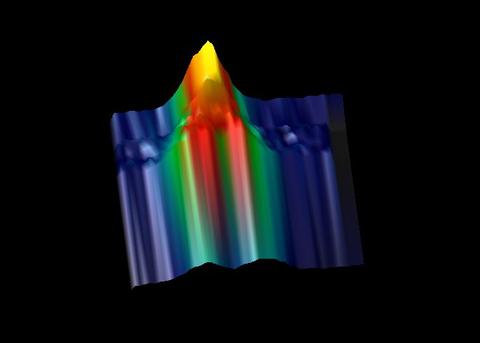
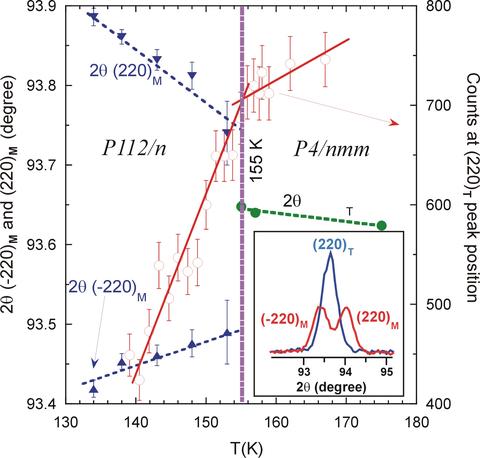
(Left) Graphical representation of the splitting of the {220} peak as the structural phase transition proceeds. The horizontal axis is diffraction angle, and the vertical axis is temperature. (Right) quantitative data. If you follow the peaks from low temperature where they are well separated, the peaks move towards each other with increasing temperature, suggesting a second order type transition, but then the peaks rapidly collapse into a single peak, which could indicate that the transition is actually weakly first order. This is an aspect that needs further detailed measurements in the vicinity of the transition.
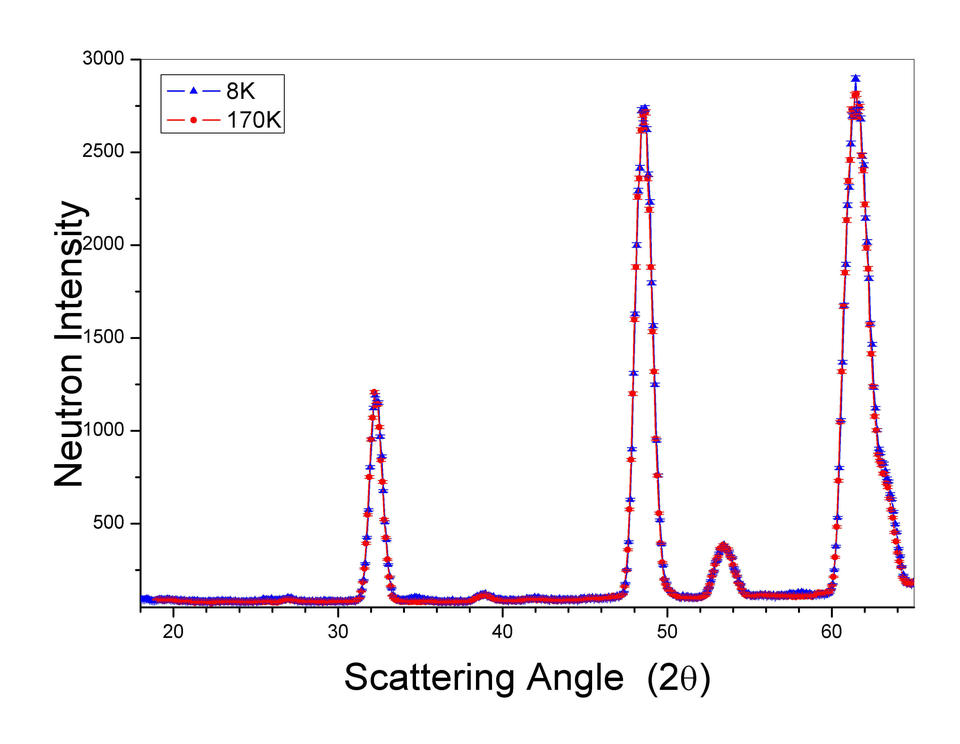
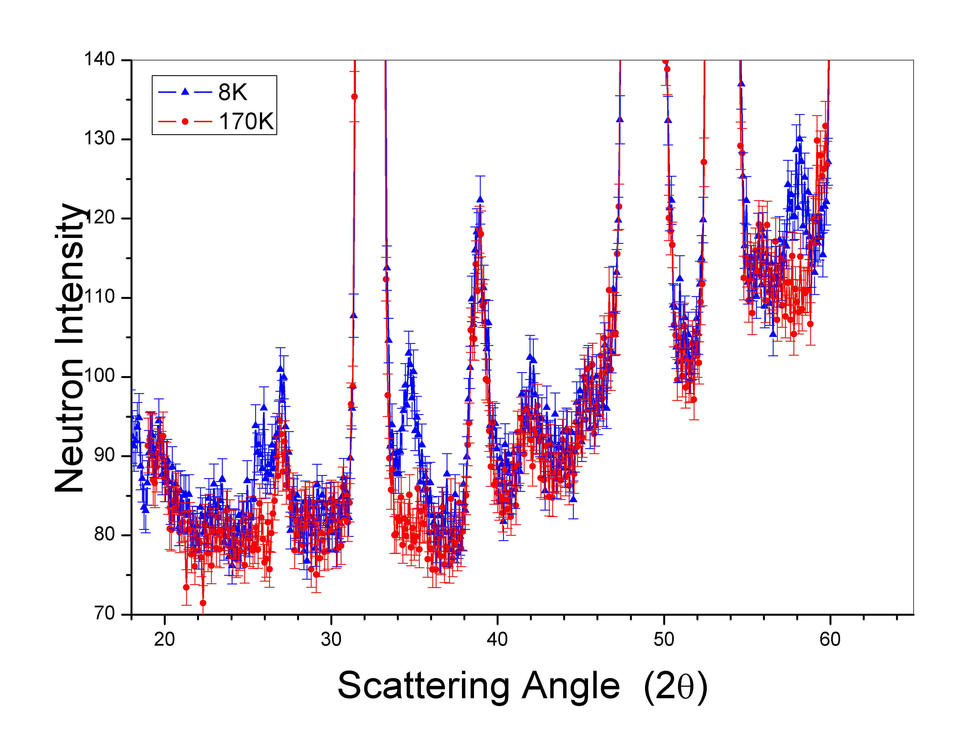
Two versions of the coarse resolution/high intensity diffraction data obtained on BT-7. The first one shows full scale, where the magnetic peaks are barely discernible. The expanded intensity scale reveals three magnetic peaks observed at low temperature (blue points). Two additional magnetic peaks occur under the strong fundamental structural peaks, and are evident when a subtraction is performed. Red points were taken at 170 K.
The structural transition was a surprise as it was thought that the strong anomalies in the bulk properties were due to the formation of a spin-density-wave magnetic state. But even more of a surprise was the observation that the magnetic transition occurred at a temperature that was substantially below the structural transition. To make absolutely certain that these were two separate transitions, the magnetic order parameter was re-measured at the High Flux Isotope Reactor at Oak Ridge National Lab, with identical results.
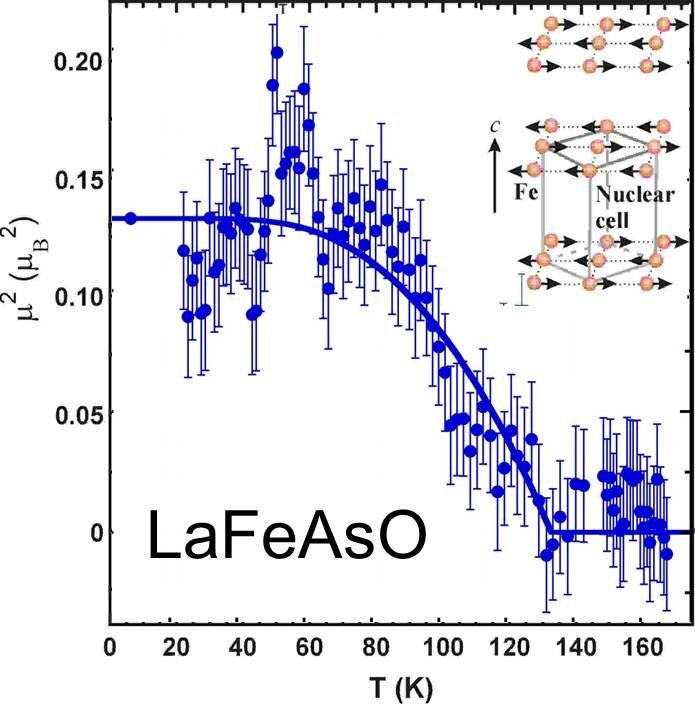
Magnetic structure and order parameter (solid blue points) obtained at the NCNR. Repeat of the order parameter measurement was done at HFIR.
 Recent Publications Return to Home page
Recent Publications Return to Home page

